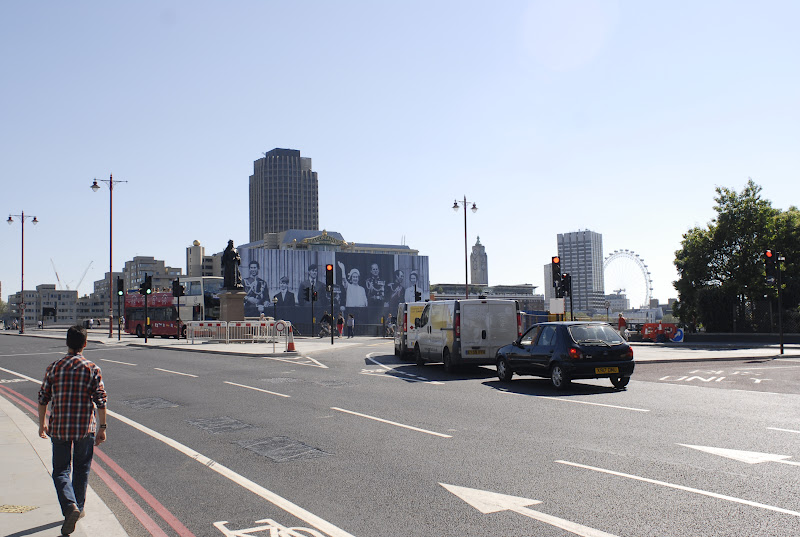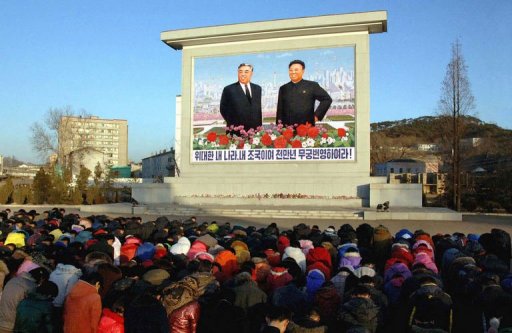This is an analysis of a British Royal Family poster displayed during the Diamond Jubilee of Queen Elizabeth II, on the banks of the river Thames, London.
The British Royal Family poster was erected in early May 2012 and remained there until after the London 2012 Olympics, which were held during August.
Official celebrations of the Diamond Jubilee took place on the weekend of 2nd and 3rd of June. A bank holiday was declared for Monday 4th and Tuesday 5th to fit the many events.
Similar posters are also used by the North Korean Kim Sung Dynasty since the 1950s, to portray the larger-than-life charisma of their members.
 |
| British Royal Family. |
Kim Il Sung father and Kim Jong Il son, dynastic leaders of North Korea.
Posters are the most clear indication that cult of personality techniques are being used by the families in question or by the state echelons assigned to keep the cult going.
The original British Royal Family picture was taken in 1977 during a previous royal anniversary, reflecting the British cult emphasis on tradition, continuity and "the eternal yesterday".
Not too dissimilar from North Korean posters which constantly refer to the war against South Korea of 1950-53 as an 'heroic war' in which the definitive identity of the country was forged.
"A cult of personality arises when an individual uses mass media, propaganda or other methods to create an idealised and heroic public image, often through unquestioning flattery and praise." Max Weber.
"A cult of personality is similar to a hero worship except that it is established by mass media and propaganda." Max Weber.
Hero worship: of the eight royals in the picture, four are wearing uniforms with full display of medals.
Each head in the poster is approximately 6 meters high. A similar size of head is displayed in North Korean 'Great Leader' Kim il-Sung and 'Dear Leader' Kim Jong-il posters.
The purpose is to produce an impression that the leaders are bigger than other human beings, with a 'larger-than-life' personality to boot, capable of great heroic deeds in all fields of human endevour.
A notion of unattainable position and power is transmitted to the rest of the population, who are unlikely to ever meet the leaders in person.
The purpose is to produce an impression that the leaders are bigger than other human beings, with a 'larger-than-life' personality to boot, capable of great heroic deeds in all fields of human endevour.
A notion of unattainable position and power is transmitted to the rest of the population, who are unlikely to ever meet the leaders in person.
_3.jpg) |
| Prince Charles. |
 |
| Kim Jong-il. |
_5.jpg) |
| Prince Andrew. |
_6.jpg) |
| Lord Mountbatten. |
+7.jpg) |
| Queen Elizabeth II. |
A worker puts the poster into position abseiling from the 70-meter high poster frame.
.jpg) |
| Propaganda painting of Kim il-Sung showing him in his later years, with more experience, maturity, confidence and a perfect set of fake teeth. |
Cult of personality techniques should be easily recognizable by people except if they:
1. Have been brainwashed by the cult.
2. Are involved in creating the cult.
3. Benefit directly from the cult.
Foreign visitors that are not influenced by the culture creating the local cult show surprise at the crude techniques used. But the same visitors are unable to recognise similar methods applied in their own country.
This is the case of British tourists and journalists visiting North Korea. They are shocked at the adulation and cult of personality shown by public officials to the Sung Family but don't to see that the techniques being applied in their own country are also part of a cult of personality propaganda, like the giant poster of the British Royal Family described here.
Only one of the decorated persons in the British royal family group photograph actually saw active service. All the others are only pretending to be military leaders, a remnant of 'hero worship'.
_9.jpg) |
| Captain Mark Phillips. |
The three principal types of cult of personality are:
1. Charismatic Authority (familial and religious).
Charismatic authority grows out of the personal charm or the strength of an individual personality. Followers obey the charismatic leader because they believe in him. Fidel Castro is a classic example of this authority.
2. Traditional Authority (patriarchs, patrimonial, feudal).
Monarchy falls largely into this category. The legitimacy of the authority comes from tradition or custom described as "the authority of the eternal yesterday". Inequalities are created and preserved by traditional authority. Should this authority not be challenged, the dominant group will stay in power for decades or even centuries. In the past, traditional power blocked the development of rational-legal authority.
3. Legal Authority (modern law, state, bureaucracy).
Known as legal-rational authority where an individual exerts power by virtue of the legal office that they hold, such as a Prime Minister or President.
Philosopher Max Weber did not live through the late XX century mass media of film and TV so he missed out on what it could possibly be a fourth type of cult of personality.
Possible addition: 4. Media Authority (TV, film, Internet, sports).
This new type could refer to the authority granted purely by the repetition of a of a deed as multiplied by mass media. Sportsmen, actors and musicians could enter a position of authority via way of being accepted by the majority of the population of the world, continent or country. Such would be the case of Gangnam Style, David Beckham, David Bowie, Ronald Reagan, George Clooney, Rolling Stones, Angelina Jolie, Pele, John Lennon, Usain Bolt and many others.
The massive poster is 100x70 meters. It is much larger and expensive than the ones created for Kim il-Sung's family dynasty in North Korea.
Most countries have abandoned giant posters but they are still visible in North Korea and at least in this case, Great Britain.
They are part of the adulation of the leader by whoever benefits from the cult.
They are part of the adulation of the leader by whoever benefits from the cult.
The British Royal Family poster was erected to be part of a 'Water Parade' involving 1,000 boats on the river Thames.
The British cult of personality also included a concert for 30,000 'subjects-worshipers' outside Buckingham Palace and numerous public appearances and state lunches and dinners.
Events during the four days were widely covered by the British mass media, mainly in the form of 24-hour coverage by the state television channel BBC.
Private TV channels showed selected events while the many magazines and newspapers carried pictures and stories of the Queen and her family for several days.
In North Korea mass media is controlled by the State, which follows cult of personality activities by the leaders, which are all members of the Kim family dynasty.
The British and North Korean states favours large public events that transmit the idea that the leader of the nation is worshiped by its people.
Sophisticated techniques alongside crude ones are used to make sure no criticism is directed against the authority of the leader.
A public appearance by the 'Dear Leader' of North Korea.
The Mall, London. Diamond Jubilee Concert attendees, June 2012.
A powerful structure of scaffolding that took several days to erect holds the British royal family poster in place covering the entire facade of a riverside building.
The North Korean family posters are more modest in size but the message is similar.
Between 1930 and 1970 was the heyday of cult of personality practices in many countries.
China used to practice cult of personality with Chairman Mao but it is now relatively abandoned.
"The happy life Chairman Mao give us"
1950s Chinese propaganda poster showing a happy family
of five enjoying life under the image of Mao Zedong.
of five enjoying life under the image of Mao Zedong.
 |
| The British cult penetrates households in different forms. This picture shows sale of tea mugs with the image of the Queen during a royal public event. |
 |
| A 'Royal Stamp' of approval with the effigy of the Queen in the classical Greco-Roman style favoured by the British Monarchy is officially in use by the state-owned Post Office. |
Cult of personality has been around for centuries but propaganda techniques in use today use modern methods of communication and mass media.
The Korean dictatorship and the British Royal Family both display a penchant for 1950s presentation of authority worship.
Note: Research and some of the quotations in this study are based on the works by Max Weber.
This blog was updated in February 2013.
This blog was updated in February 2013.





.JPG)


_8.jpg)























